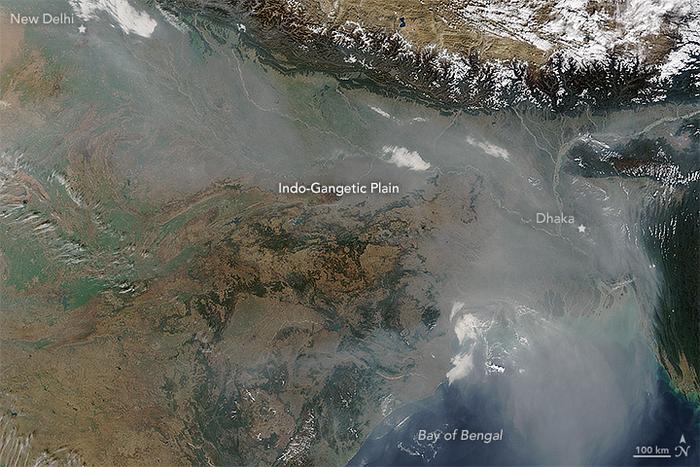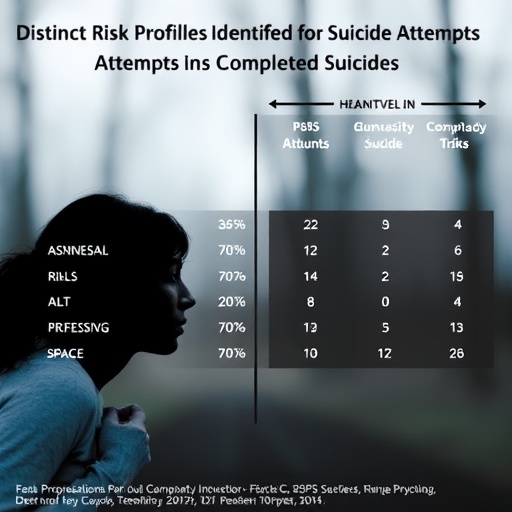Fine particulate matter comes from wood burning, power generation, motor vehicles and other combustion sources that emit tiny particles into the air. At only 2.5 micrometers or smaller, these particles are small enough to be inhaled and cause lasting damage to the heart and lungs. Known as PM2.5, exposure to these particles is a leading mortality risk factor in India and the surrounding region of South Asia.

Credit: Martin lab, Washington University in St. Louis
Fine particulate matter comes from wood burning, power generation, motor vehicles and other combustion sources that emit tiny particles into the air. At only 2.5 micrometers or smaller, these particles are small enough to be inhaled and cause lasting damage to the heart and lungs. Known as PM2.5, exposure to these particles is a leading mortality risk factor in India and the surrounding region of South Asia.
A new study by researchers in Randall Martin’s lab in the McKelvey School of Engineering at Washington University in St. Louis evaluated the contribution of various emission sectors and fuels to PM2.5 mass for 29 states in India and six surrounding countries: Pakistan, Bangladesh, Nepal, Bhutan, Sri Lanka and Myanmar.
The results, published July 7 in Environmental Science & Technology, identify primary organics — organic particles emitted directly into the atmosphere from various sources — as the main drivers of high concentrations of PM2.5 over South Asia. The paper also illuminates potential pathways to reduce PM2.5 mass and improve population health across South Asia.
“Countries in South Asia have substantial emissions and associated air pollution and mortality burden,” said first author Deepangsu Chatterjee, a doctoral student in energy, environmental & chemical engineering in the McKelvey School of Engineering. “Our study shows that over 1 million deaths in South Asia attributable to ambient PM2.5 in 2019 were primarily from residential combustion, industry and power generation. Solid biofuel is the leading combustible fuel contributing to the PM2.5-attributable mortality, followed by coal and oil and gas.”
“Air pollution, both indoors and outdoors, is the leading risk factor for death in South Asia,” said co-author Michael Brauer, professor at the Institute for Health Metrics and Evaluation at the University of Washington and the University of British Columbia. “Understanding the major contributing sources is a critical first step towards management of this serious problem.”
A major challenge in evaluating the impacts of PM2.5 is understanding how it is produced and distributed over time. Chatterjee and Martin, the Raymond R. Tucker Distinguished Professor in McKelvey Engineering, combined global emission inventories, satellite-derived fine surface particulate matter estimates and state-of-the-art global scale modeling capabilities to develop regional simulations. They also accounted for long-range transport to understand how different emission sectors and fuels contributed to PM2.5 and associated mortality rates.
“Advances in modeling atmospheric composition with constraints from satellite remote sensing enabled our assessment of the sources of PM2.5 across South Asia,” Martin said. “That helped draw our attention to large contributions from burning biofuel and coal.”
Chatterjee also noted that PM2.5 mass composition in South Asia is driven by primary organics across major contributing sectors. The team’s PM2.5 composition analysis can be particularly useful to develop mitigation strategies associated with particular species.
A few other notable features include high contribution from coal in central and eastern India, higher household air pollution in north-east and central India, biofuel contributions in Bangladesh and open fires in Myanmar.
“This study shows that the air pollution problem in South Asia is not just an urban scale problem, so policies targeted at urban scale development will not be enough to mitigate the national level PM2.5 exposure,” Chatterjee said.
Chatterjee, Martin and their co-authors suggest several strategies for future interventions throughout South Asia, including policies encouraging the replacement of traditional fuel sources with sustainable sources of energy.
“Policies in India in the past five to 10 years have worked toward identifying and improving air pollution concerns and associated health burden and mortality risks. Seeing these policies be effective is motivating for the South Asian population to keep moving the needle and develop strategic policies to curb the growth of air pollution,” Chatterjee said. “Our paper provides detailed sector-, fuel- and composition-based information for different states in India along with surrounding countries, which could be useful for local policymakers to eliminate PM2.5 sources associated with their specific region.”
Chatterjee D, McDuffie EE, Smith SJ, Bindle L, van Donkelaar A, Hammer MS, Venkataraman C, Brauer M, Martin RV. Source contributions to fine particulate matter and attributable mortality in India and the surrounding region. Environmental Science & Technology, July 7, 2023. DOI: https://pubs.acs.org/doi/10.1021/acs.est.2c07641
This work was supported by NASA (80NSSC21K0508) and the Health Effects Institute, an organization jointly funded by the U.S. Environmental Protection Agency (R-82811201) and certain motor vehicle manufacturers.
Originally published by the McKelvey School of Engineering.
Journal
Environmental Science & Technology
DOI
10.1021/acs.est.2c07641
Method of Research
Observational study
Subject of Research
Not applicable
Article Title
Source Contributions to Fine Particulate Matter and Attributable Mortality in India and the Surrounding Region
Article Publication Date
7-Jul-2023




